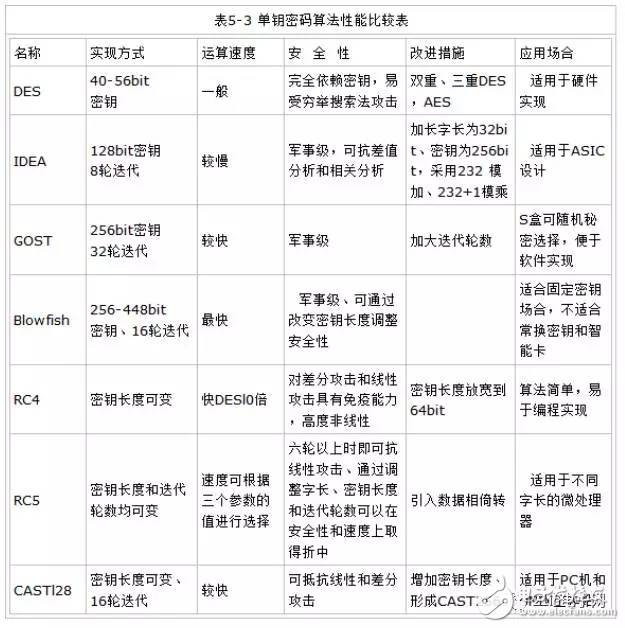
With the advent of the era of artificial intelligence and the Internet of Things, data applications have become frequent. How should data security be protected? What software encryption algorithms are there, and in what areas are these algorithms applied? As you read on, you will discover the “small passwords” surrounding us.


Symmetric encryption algorithms are among the earliest encryption algorithms and are technically mature. In symmetric encryption algorithms, the data sender processes the plaintext (original data) along with the encryption key through a special encryption algorithm, transforming it into complex encrypted ciphertext for transmission. In symmetric encryption algorithms, only one key is used, which both the sender and receiver use to encrypt and decrypt data. This means that the decryption party must know the encryption key in advance. The characteristics of symmetric encryption algorithms are that the algorithm is public, the computational load is small, the encryption speed is fast, and the encryption efficiency is high. However, the drawback is that both parties use the same key, which does not guarantee security. Symmetric encryption algorithms are relatively difficult to use in distributed network systems, mainly due to the difficulty of key management and high usage costs.
DES Encryption Algorithm
DES (Data Encryption Standard) is a block cipher that encrypts data in 64-bit blocks, with a key length of 56 bits, using the same algorithm for both encryption and decryption. The DES encryption algorithm keeps the key confidential while the algorithm itself is public, including the encryption and decryption algorithms. Therefore, only those who possess the same key as the sender can decipher the ciphertext encrypted by the DES algorithm. Thus, breaking the DES encryption algorithm essentially involves searching for the key encoding. For a key length of 56 bits, the number of operations required for an exhaustive search is 2^56.
As computer system capabilities continue to develop, the security of DES is much weaker than when it first appeared; however, from a practical non-critical perspective, it can still be considered sufficient. Nevertheless, DES is now only used for authentication in legacy systems, with newer encryption standards being preferred.
3DES Encryption Algorithm
3DES (Triple DES) is a block cipher that applies the DES encryption algorithm three times to each data block. Due to enhanced computational capabilities, the original DES key length has become vulnerable to brute-force attacks; 3DES was designed to provide a relatively simple method of increasing the DES key length to avoid similar attacks, rather than creating an entirely new block cipher algorithm.
3DES serves as a transitional encryption algorithm from DES to AES (Advanced Encryption Standard), with the encryption process defined as follows: let Ek() and Dk() represent the encryption and decryption processes of the DES algorithm, K represent the key used by the DES algorithm, M represent the plaintext, and C represent the ciphertext, thus:
The 3DES encryption process is: C=Ek3(Dk2(Ek1(M)))
The 3DES decryption process is: M=Dk1(Ek2(Dk3(C)))
AES Encryption Algorithm
AES (Advanced Encryption Standard) is a symmetric block cipher used in cryptography, with a minimum supported key length of 128, 192, or 256 bits and a block length of 128 bits. The algorithm is designed to be easily implemented in various hardware and software. This encryption algorithm is the block encryption standard adopted by the U.S. federal government to replace the original DES, and it has been widely analyzed and used globally.
AES is designed to support data block sizes of 128/192/256 bits and key lengths of 128/192/256 bits, corresponding to approximately 3.4×10^38, 6.2×10^57, and 1.1×10^77 keys in decimal.


Asymmetric encryption algorithms use two completely different but perfectly matching keys—a public key and a private key. When using an asymmetric encryption algorithm to encrypt a file, only the matching pair of public and private keys can complete the encryption and decryption process of the plaintext. When using asymmetric encryption algorithms, the receiving party must send their randomly generated public key to the sender before communication while keeping the private key. Because asymmetric algorithms use two keys, they are particularly suitable for data encryption in distributed systems. Widely used asymmetric encryption algorithms include the RSA algorithm and the DSA proposed by the U.S. National Institute of Standards and Technology. Encryption technologies based on asymmetric algorithms are extensively applied.
RSA Encryption Algorithm
The RSA encryption algorithm is currently the most influential public key encryption algorithm and is widely regarded as one of the best public key schemes. RSA is the first algorithm that can be used for both encryption and digital signatures, capable of resisting all known cryptographic attacks to date, and is recommended by ISO as the standard for public key data encryption. The RSA encryption algorithm is based on a very simple number theory fact: multiplying two large prime numbers is easy, but factoring their product is extremely difficult, thus allowing the product to be made public as the encryption key.
DSA Encryption Algorithm
DSA (Digital Signature Algorithm) is based on the discrete logarithm problem over finite fields, with a security level comparable to RSA. An important feature of DSA is that two prime numbers are public, allowing verification of whether they are randomly generated or manipulated, even without knowing the private key. RSA cannot accomplish this. DSA is merely an algorithm; unlike RSA, it cannot be used for encryption and decryption or key exchange, only for signing, and it is significantly faster than RSA.
ECC Encryption Algorithm
The Elliptic Curve Cryptography (ECC) is a public key encryption system initially proposed by Koblitz and Miller in 1985, based on the difficulty of computing discrete logarithms over rational points on elliptic curves. Public key cryptosystems are generally classified into three categories based on the problems they rely on: integer factorization problems, discrete logarithm problems, and elliptic curve problems. Sometimes, elliptic curve problems are classified under discrete logarithm problems. The elliptic curve cryptosystem is currently known to provide the highest encryption strength per bit among public key systems. The best algorithm for solving the discrete logarithm problem on elliptic curves is the Pollard rho method, which has a time complexity that is completely exponential.


Irreversible encryption algorithms are characterized by not requiring a key during the encryption process. After inputting the plaintext, the system directly processes it into ciphertext using the encryption algorithm, and the resulting data cannot be decrypted. Only by re-entering the plaintext and processing it through the same irreversible encryption algorithm can the same ciphertext be obtained and recognized by the system. Common irreversible encryption algorithms in computer networks include the MD5 algorithm invented by RSA and the irreversible encryption standard SHS proposed by the U.S. National Institute of Standards and Technology.
MD5 Encryption Algorithm
MD5 (Message-Digest Algorithm 5) is a widely used hash function in the field of computer security to provide message integrity protection. A brief description of the MD5 encryption algorithm is that it processes input information in 512-bit blocks, with each block divided into 16 sub-blocks of 32 bits. After a series of processing, the algorithm outputs a 128-bit hash value composed of four 32-bit blocks.
MD5 is widely used for password authentication and key identification in various software. MD5 uses a hash function, and its typical application is to generate a message digest to prevent tampering. A typical application of MD5 is to produce a fingerprint of a message to prevent “tampering”. If a third-party certification authority is involved, MD5 can also prevent the file author from “denying” authorship, which is known as digital signature application. MD5 is also widely used in operating system login authentication, such as UNIX, various BSD systems login passwords, digital signatures, and many other areas.
SHA1 Encryption Algorithm
SHA1 (Secure Hash Algorithm 1) is a popular message digest algorithm similar to MD5. The SHA encryption algorithm is modeled after the MD4 encryption algorithm. SHA1 is designed to be used with the Digital Signature Algorithm (DSA).
SHA1 is primarily suitable for the digital signature algorithm defined in the digital signature standard. For messages less than 2^64 bits in length, SHA1 produces a 160-bit message digest. When a message is received, this message digest can be used to verify data integrity. During transmission, data may change, resulting in a different message digest. SHA1 cannot recover information from the message digest, and two different messages will not produce the same message digest. Thus, SHA1 can verify data integrity, making it a technique to ensure file integrity.
SHA1 encryption algorithm can accept data inputs of up to 2^64 bits and produce a 160-bit digest. The input is divided into 512-bit blocks and processed individually. A 160-bit buffer is used to hold the intermediate and final results of the hash function, which can be represented by five 32-bit registers (A, B, C, D, and E). SHA1 is a more secure algorithm than MD5; theoretically, all digital verification algorithms that use the “message digest” method have “collisions”—that is, two different items produce the same message digest, which is how mutual cheating occurs. However, finding a specified data “collision” is difficult for secure algorithms, and calculating a “collision” using formulas is even more difficult; so far, only MD5 has been cracked among commonly used secure algorithms.
Of course, in addition to the aforementioned encryption algorithms, there are other methods, and I found a chart as a supplement. (Reprinted from Electronic Enthusiasts)


1.Considerations for C Language in Embedded System Programming
2.Learning Roadmap for Embedded Software!
3.Hard Links and Soft Links in Linux File System
4.Try Micro Bit for Embedded Programming!
5.How to Get Started with AI with Poor Programming and Math Foundations?
6.Command Link Operators in Linux to Simplify Your Code!

Disclaimer: This article is a reprint from the internet, and the copyright belongs to the original author. If there are any copyright issues with the work, please contact us, and we will confirm the copyright based on the materials you provide and pay fees or delete the content accordingly.